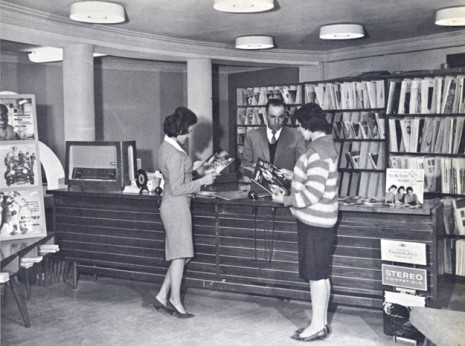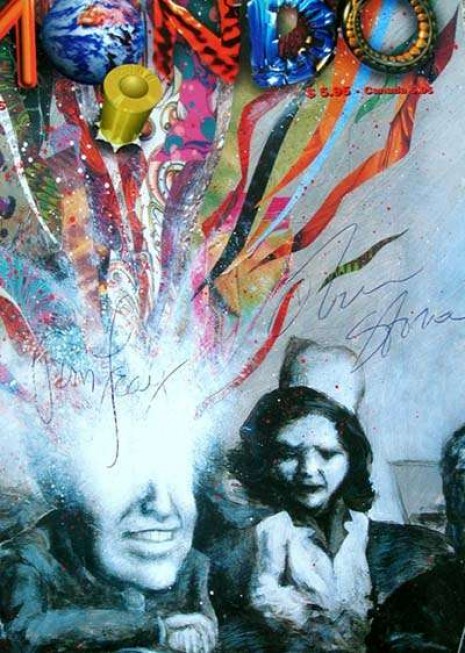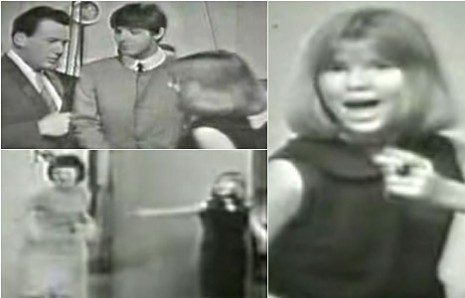
Last month, Britain’s new Defense Minister, Liam Fox, described Afghanistan as a “broken 13th-century country” and indeed this is what we are told frequently, that Afghanistan is scarcely more advanced than a medieval society and its barren, rocky terrain indistinguishable from the lunar surface. But it wasn’t always that way. Not at all. And things were much different for women, too…. not long ago, in fact.
Mohammad Qayoumi, president of California State University, East Bay, writes in Foreign Policy:
But that is not the Afghanistan I remember. I grew up in Kabul in the 1950s and ‘60s. When I was in middle school, I remember that on one visit to a city market, I bought a photobook about the country published by Afghanistan’s planning ministry. Most of the images dated from the 1950s. I had largely forgotten about that book until recently; I left Afghanistan in 1968 on a U.S.-funded scholarship to study at the American University of Beirut, and subsequently worked in the Middle East and now the United States. But recently, I decided to seek out another copy. Stirred by the fact that news portrayals of the country’s history didn’t mesh with my own memories, I wanted to discover the truth. Through a colleague, I received a copy of the book and recognized it as a time capsule of the Afghanistan I had once known—perhaps a little airbrushed by government officials, but a far more realistic picture of my homeland than one often sees today.
A half-century ago, Afghan women pursued careers in medicine; men and women mingled casually at movie theaters and university campuses in Kabul; factories in the suburbs churned out textiles and other goods. There was a tradition of law and order, and a government capable of undertaking large national infrastructure projects, like building hydropower stations and roads, albeit with outside help. Ordinary people had a sense of hope, a belief that education could open opportunities for all, a conviction that a bright future lay ahead. All that has been destroyed by three decades of war, but it was real.
I have since had the images in that book digitized. Remembering Afghanistan’s hopeful past only makes its present misery seem more tragic.
I highly recommend clicking through all 24 pages of this photo essay, Once Upon a TIme in Afghanistan. It’s a fascinating look at a society that was so vibrant and thriving in the 1950s and 1960s, but is now in a hell of a mess. Some of these photographs are likely to stop you in your tracks when you consider the implications of what happened to this culture. HOW could things have gotten this much worse in 40 years?!?! It’s just incredible to contemplate. A cautionary tale of the very worst, most depressing kind.
Once Upon a Time in Afghanistan (Foreign Policy)

Some artists, like Picasso and Dali, were discovered when they were young and their talents grew to maturity before the public eye. Sometimes, however it takes,,, well, dying before the art world sits up and takes notice of you, This has certainly been the case with Brion Gysin, the Canadian/British painter and author who has long stood in the shadows, figuratively speaking, of William S. Burroughs, his lifelong friend and collaborator. Burroughs once said that Brion Gysin, the inventor of the Cut-Ups literary technique was the only man he ever truly respected.
Gysin is an artist whose work must be seen in person to be truly appreciated. This is said about every artist’s work, but it’s particularly true with Brion Gysin. What might appear to be random chicken scratch calligraphy when reproduced in a book, becomes ALIVE when seen in person. Seemingly careless hash marks become scenes of hundreds of people around a bonfire or a crowded Arab marketplace when you’re staring right at it.
The man was a master. And he left an awful lot of work behind. Although there were various Gysin gallery exhibits in New York while he was still alive—I recall being astonished by some large works on paper in a great 1985 show at the Tower Gallery—there has never been a museum level retrospective of Gysin’s work in the United States until now:
“Brion Gysin: Dream Machine” will be the first US survey of the work of Brion Gysin (b. 1916, Taplow, UK; d. 1986, Paris), an irrepressible innovator, serial collaborator, and subversive spirit who continues to inspire artists today. The exhibition will include over 250 drawings, books, paintings, photo-collages, films, slide projections, and sound works, as well as the Dreamachine—a kinetic light sculpture that utilizes the flicker effect to induce visions.
In 1959, Gysin created the Cut-Up Method, wherein words and phrases were randomly collaged to unlock unknown meanings, culminating in The Third Mind, a book-length collage created with his lifelong collaborator William S. Burroughs. Transferring the idea of the Cut-Up to magnetic tape, Gysin became the father of sound poetry. Throughout his life, Gysin was a collaborator and an inspiration to artists, poets, and musicians, such as John Giorno, Brian Jones, David Bowie, Patti Smith, Genesis-P-Orridge, and Keith Haring.
More than two decades after his death, his work continues to attract the interest of a new generation of artists drawn to Gysin’s radical inderdisciplinarity, including Rirkrit Tiravanija, Cerith Wyn Evans, Trisha Donnelly, and Scott Treleaven. The exhibition is curated by Laura Hoptman, Kraus Family Senior Curator, and will be on view in the New Museum’s second-floor gallery. It will be accompanied by an illustrated catalogue co-published with Hugh Merrell, Ltd. which will include scholarly essays and appreciations by contemporary artists, musicians, and poets.
Video below, a trailer for FLicKer a Canadian documentary about Gysin directed by Nik Sheehan, in which I make a brief appearance.

WHAT were they thinking?! Methinks the store, New Form, took it a bit too far.
The advertising slogan tells the store’s teenage and twenty-something target market to “Change Style – Don’t Follow Your Leader”.
Poster of Adolf Hitler wearing pink SS uniform sparks outrage in Italy
(via Nerdcore)

The house that spooked the shit out of the family Lutz, and, later, readers of Jay Anson’s account of it, The Amityville Horror, went on the market yesterday. The 5 bedroom Dutch Colonial can be yours for just 1.5 million. But, as they say, buyer beware:
The house has a history of terror. The Lutz family moved into the house in 1975 after it went on sale because the former were all killed in the home with the exception of the eldest son, Ronald DeFeo Jr. who was convicted of killing his family.
The horror house left the Lutz’s moving out with a tale to tell that was made into an Oscar nominated film starring James Brolin and Margot Kidder as the Lutz family who were only able to stay in the house for a brief time. Neighbors say people still gawk at the home and it draws a crowd on Halloween. How much of the story the Lutz’s told was true, but if the house sells, and some brave family moves in, we may find out.
Attn: potential new tenants of Amityville Horror house: if that demonic pig, Jodie, pops up again, please send him to Park Slope, Brooklyn, c/o Jonathan Safran Foer. You got that? Park Slope!
Previously on Dangerous Minds: The Merv Griffin-Amityville Horror Summit

Relatively new to Youtube is this 2008 documentary in its three hour (!) entirety. I’ll admit I haven’t watched the whole thing yet so can’t vouch for quality, though it evidently touches on the whole beloved Krautrock spectrum. Hell, I’d watch a documentary about plumbing if it had something about Can in it, so I’ll be diving right into this one shortly.

So begins R.U. Sirius’s history of Mondo 2000 magazine and its circle of fellow travelers. I approve of how it starts with this wonderful personal anecdote about his first exposure to the underground press as a teen, in the form of the San Francisco Oracle. Many people will tell you of an “Oh wow! This exists! And there must be more of it!” epiphany like this—I had a similar experience discovering David Bowie and reading Lester Bangs in Creem magazine eight years later—and it’s a highly enjoyable essay. Worth pointing out that kids today and forevermore will be unable to have an experience like this due to the always on mediascape we inhabit today. Discovering something rare used to require luck, a knack for ferreting out weird stuff or a hip relative. Not saying it would be preferable to go back to this earlier era, of course, I’m just saying that back then it took work:
Let the story beginning in the Spring of 1967. I am 14 years old and in 9th grade. It’s early evening and the doorbell rings at the suburban house in Binghamton, New York where I live with my mom and dad. It’s a group of my friends and they’re each carrying a plastic bag and looking mighty pleased. They come in, we shuffle into the guest room (where the record player is kept) and they show off their gatherings — buttons (“Frodo Lives!” “Mary Poppins is a Junkie” “Flower Power”), beads, posters (hallucinatory), incense with a Buddha incense burner, and kazoos. A lonely looking newspaper lays at the bottom of the pile, as though shameful, the only item unremarked.
Without realizing the implications, I happen to throw side one of Between The Buttons on the player. Eventually, the song “Cool Calm and Collected” plays and a kazoo sounds through the speakers. In an instant, newly purchased kazoos are wielded and The Rolling Stones only-ever kazoo solo is joined by three wailing teenagers, bringing sudden shouts of objection from my famously liberal and tolerant Dad in the living room. It’s quickly determined that it’s late, Dad’s tired, and it’s time to send all kazoo-wielding teens packing. As each of the friends moves to retrieve his items, I grab the newspaper to see what it is. There are, I now see, two of them — two editions of something called “The Oracle.” It has hallucinatory visuals on the cover and boasts an interview with a member of The Byrds (David Crosby). Vinnie, who had bought it — but who, despite writing poetry — avoids any signifiers of intellectual curiosity as the teen status crushers that they are, feigns disinterest and gives the copies to me.
And that’s where it begins, this strange love affair with the periodical, particularly the periodical that has flair and style… where you can almost feel the energy and fun emanating off the pages.
I remember only one thing from the content inside those two Oracles and that’s David Crosby denying that he was “some kind of weird freak who fucks ten chicks a day.” That stuck in my mind. I didn’t know it was possible even to think that, much less print it, much less be in a position to find it necessary to deny being it!
How great is that last sentence?
Read the entire essay—and support the project—here.

The current Arthur‘s running a lengthy piece entitled, “Out! Demons Out!: An Oral History of the 1967 Exorcism of the Pentagon and the Birth of Yippie!” Dangerous Minds hero Kenneth Anger is just one of the many voices chiming in (Allen Ginsberg, Paul Krassner, and Ed Sanders are others), but, judging from the snips below, the filmmaker’s bluntly amusing jabs might be hard to top. Here’s his take on what it was like infiltrating the Pentagon:
There were a bunch of idiots there. I didn’t consider myself an idiot, but maybe other people would. [laughs] There were these hothead lefties, who, their idea was they would take over and kill the capitalists. Well, that’s not very practical. Then there were Hare Krishnas, peacenik idiots, saying peace peace, or something like that. I didn’t go for anything like that. It was so annoying.
I just walked right in. I had studied how the Pentagon staff were dressed, and I was just like them. I wore a dark blue conservative suit. I even had a small American flag on my lapel. I was attacking Mars, the god of War. He’s still our ruling god. If you think Mars is an extinct thing from the antique past that we can just laugh at now, forget it. Mars is still here.
I had a map of the Pentagon. I went into every single men’s room and left—in a place where it was bound to be discovered, usually on the seat where anyone using that stall would have to see it, not on the floor, of course! —a talisman which was written on parchment paper, drawn in india ink. Each one was drawn individually using one of Crowley’s talismans as my guide. I’m sure no one in the Pentagon could figure out what this thing meant. There was nothing like “War is bad” on it. There weren’t even English words. They probably could figure out it was something occult. They know about those things, and they have a reference library.
I went from one men’s room to the next. I didn’t stop until I had scattered all 93 of my talismans—because 93 is a sacred number for Crowley. Then I walked out, it was all very inconspicuous. The security guard looked at me and gave me a nice look, like we’re all looking after each other. If I’d been stopped and put in handcuffs that would’ve been unpleasant. That isn’t the way I want to spend my time in Washington—I had a ticket to the opera for later that week.
Won’t you now take some time out for a Puce Moment?

John and I wrote She’s Leaving Home together. It was my inspiration. We’d seen a story in the newspaper about a young girl who’d left home and not been found, there were a lot of those at the time, and that was enough to give us a story line. So I started to get the lyrics: she slips out and leaves a note and then the parents wake up ... It was rather poignant. I like it as a song, and when I showed it to John, he added the long sustained notes, and one of the nice things about the structure of the song is that it stays on those chords endlessly. Before that period in our song-writing we would have changed chords but it stays on the C chord. It really holds you. It’s a really nice little trick and I think it worked very well.
While I was showing that to John, he was doing the Greek chorus, the parents’ view: ‘We gave her most of our lives, we gave her everything money could buy.’ I think that may have been in the runaway story, it might have been a quote from the parents. Then there’s the famous little line about a man from the motor trade; people have since said that was Terry Doran, who was a friend who worked in a car showroom, but it was just fiction, like the sea captain in “Yellow Submarine”, they weren’t real people.
The Daily Mirror story that inspired She’s Leaving Home was about Melanie Coe, then aged 17. Wild child Coe snuck out of her parents comfortable North London home in February of 1967. She was pregnant and afraid of what her mother might do, but had not run off with the father of her unborn child—or “a man from the motor trade,” for that matter—rather with a croupier she’d met. They shacked up for a week before her parents found her. She later had an abortion.
But here’s the weird part: three years earlier Coe had actually met Paul McCartney when he was the judge of a miming contest that Coe won on Ready, Steady, Go! Coe mimed to Brenda Lee’s Let’s Jump The Broomstick and Macca gave her the award. Winning the contest meant Coe would be a dancer on the show for an entire year.